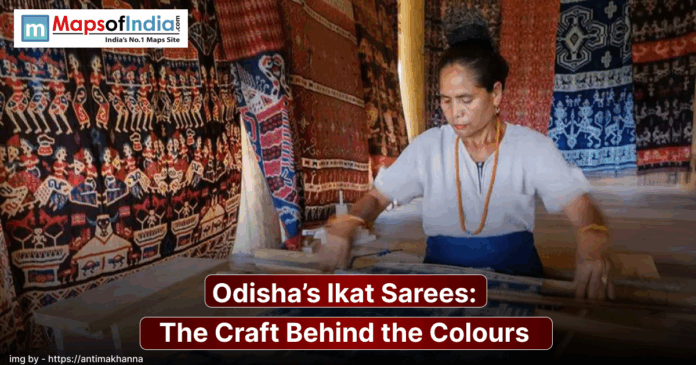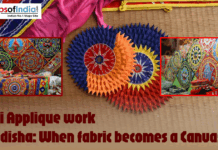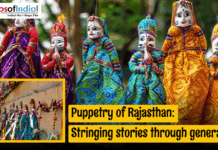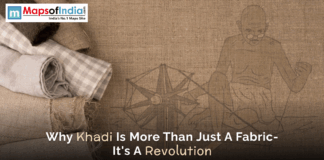The Ikat sarees in Odisha are one of the most famous and well-known handmade textile styles of making sarees in India. These sarees are known for their vivid colours and complex patterns that attract most of the attention. This type of clothing is known as Bandha among the locals. In the traditional saree-making technique of Ikat, we can see a blend of Odisha art, and there is precision and devotion. This craft is not only about the technique of saree making, but at the same time, it’s about how they express their culture.
Origin of Ikat in Odisha
The start of the Ikat weaving tradition that is practised in Odisha dates back to various centuries. According to various research reports, it has been believed that this art has been developed through the cultural exchanges that have been happening with Southeast Asia and other parts of India. The craft evolved after getting royal patronage, and with time, it also became a part of temple traditions and festivals in local regions.
Meaning of Ikat
The meaning of the word Ikat has been derived from the Malay-Indonesian term “mengikat”, the word means to tie or bind. Those who practice this technique involve resisting the urge to dye the threads before weaving. Using this will give the pattern used in this craft its signature blurred edges, which can only be seen in the Ikat weaving. The entire process requires great skill, precision and patience from the weaver.
The Three Main Types of Odisha Ikat
The technique of ikat has three major styles of Ikat weaving. These three styles are different in their own way, having their own motifs, colour palette and weaving method. Through which we can see the identity of the region and culture.
Sambalpuri Ikat
Sambalpuri Ikat is the most well-known variety of Odisha. In this pattern, you can see the famous intricate geometric and floral designs. The sarees created in this type most of the time feature traditional motifs like conch shells, wheels and fish. These symbols symbolizes prosperity and spirituality. Sambalpuri saris are famously worn in festivals and events across India, and the colours on these sarees are rich and vibrant. The dominating colours are red, black and white.
Bargarh Ikat
The style of Bargarh Ikatis is famous for using the delicate tie-dye technique and fine thread work while making sarees. The designs of this style take inspiration from nature, having patterns like leaves, flowers and birds. The weavers practising this style are also famous for creating double Ikat sarees, in which both warp and weft threads are dyed before weaving. This makes each piece rare and highly valued.
Nuapatna Ikat
The style of Nuapatna, which is practised near Cuttack, is a really famous technique. This technique is mostly used to produce famous Khandua sarees, which are offered to Lord Jagannath of Puri. This technique uses natural dyes and features motifs like the elephant lotus and temple borders.
The Tie and Dye Technique
The process of tie-dye is an important part of making Ikat weaving. The weavers tie small sections of the yarn using cotton threads to create the pattern you want. They tied a small section of the thread to stop the dye when the yarn is coloured. To make the complete saree, this process is repeated multiple times using different colours that can help to achieve complex designs. After completing the dyed threads process this all the threads will be aligned carefully on the loom to form the final pattern.
Materials Used in Weaving
The material used to create Ikat sarees is woven using pure cotton or mulberry silk. The material needed to use for the saree depends on the type of saree and its intended use. For everyday wear, cotton sarees are preferred. During special occasions, the white silk Ikats are prepared. The sarees made from natural raw material are comfortable, durable and breathable.
Natural Dyeing Process
The natural dyes made from plants, minerals and roots are still being used by Ikat weavers in Odisha. To get natural colours, the natural sources like Indigo, turmeric and madder root are commonly used. The dyeing process is labour-intensive but eco-friendly. It also enhances the longevity of the fabric and gives the sarees a soft, natural sheen.
Tools and Looms Used
The traditional handloom utilized in Ikat weaving is also known as the pit loom. This tool is easy to use and at the same time effective. This can help those who are weaving to manage tension and achieve accuracy in design. Some weavers who are not minding the modernization happening around them are still continuing to use hand-operated looms that will help them to preserve the originality of their work.
Challenges
There are still a large number of challenges still faced by these Ikat weavers. Challenges like changing prices of raw material, and there is still the problem of access that happens when going into new markets. Younger generations of people are moving away from continuing this craftsmanship further due to the uncertain market and financial benefits. Machine-made sarees are also covering their market.
Role of Women in Ikat Weaving
Women play an important role in the craftsmanship of Odisha’s Ikat tradition, making it famous across the globe. They do all kinds of work, like tie and dye, and they also prepare the yarn. The households that depend on this craftsmanship financially, women in these households control family finances and work in community-based cooperatives. The work they put into this ensures that the craft becomes a sustainable source of livelihood.
Cultural Importance in Odisha
The importance of Ikat sarees in Odisha is greater. It has close and significant connections with the cultural heritage of the state. These different sarees are famously used in Odisha festivals, weddings and temple rituals. The Khandua saree is annually offered to Lord Jagannath. This can be seen as the divine bonding that is happening between the craft and the religious traditions of the state. Wearing an Ikat saree is celebrating Odisha’s identity and heritage.
Conclusion
This saree-making craftsmanship is a pride of Odisha. The Ikat sarees making technique is a celebration of colour, creativity and cultural pride. Every saree created here shows us the skill, patience and imagination craftsmen took to make this work fulfilling. We can see that with evolving time, the craft has adapted a seamless blend of ancient traditions with modern sensibilities. This will continue to evolve as time passes. In every thread of an Ikat saree is the story of Odisha, its people and their ageless dedication to art.





